FAQ's (Frequently Asked Questions) & Known Compatibility Issues
Known Compatibility Issues
The KT 73 must be configured to accept serial altitude data on pin 7 of the main connector, and software configured for High Resolution M (IIMorrow). 1200bps, 7 data bits, 1 stop bit and odd parity. The Trans-Cal Digitizer must be software configured to transmit the correct serial data protocol to the Bendix/King KT 73 transponder. Refer to the digitizer installation manual.
The Narco AT-150 may sporadically reply to Mode C interrogation with erroneous altitude data. This erronous altitude data is derived from a corrupted AT-150 internal data register. The Narco AT-150 transponder requires updates as per Narco service bulletins SB AT150 No. 1 and No. 6 as applicable.
Reference: FAA AD 2004-08-16, dated 16 April 2004 and or EASA AD 2009-0200, dated 8 September 2009.
The Narco AT-5A, AT-6A, AT-50 or AT-50A transponder will not reliably accept data from Trans-Cal Altitude Digitizers. A modification to remove the output decoupling capacitors is required and the unit may be ordered from the factory with this modification. Order the Model Number best suited for your application with "Mod. 1" applied. This mod may NOT be performed in the field. Please note! The Narco AT-50 and earlier transponder models require a modification before they will function correctly with any altitude encoder. This modification is outlined in Narco Service Bulletin AT-50A-5.
The King KT-75/75R uses the older RTL (resistor transistor logic) pulling up to about 3 volts; consequently the open collectors of the digitizer will not pull the signal below the KT-75 logic threshold.
The TDR950 must be powered-up first, or the digitizer must be diode isolated to prevent the TDR 950 from invalidating the encoder data. All diodes are 1N4454 or equal.
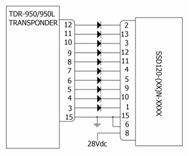
Have a question or issue you would like to see in this section? Send it to cosmo@trans-cal.com
FAQ Section
Bench Test Charge
Effective as of 1 September 2010, Trans-Cal will charge a bench test evaluation and certification fee of $100.00 for solid-state units, and $200.00 for the Model D120-P2-T. An RMA is required for all service requests. This fee is waived if the instrument is found to be defective in either workmanship or materials within the warranty period.
Test and recertification of TCI instruments is loads of work! Our instruments have a very low failure rate. As of June 2015 the Nano series altitude encoders’ failure rate within the warranty period is 0.3%. When units are returned, we don’t just test them, we cycle, burn-in, vibrate and electrically stress them for 8 to 12 hours! All this testing is required to verify the instruments we are producing are operating within our published specifications and FAA or EASA standards.
TCI bench test evaluation includes:
- A pressure altitude accuracy test compared to an NIST traceable pressure standard
- An automated altitude/vibration burn-in cycle test from minimum to maximum altitude for a period of 8 hours minimum
- An electrical stress test on all outputs to verify maximum electrical operating characteristics
- All instrument data is logged and archived. A test and certification report is generated and returned with the unit.
The vast majority of units returned to TCI are found to operate well within our published specifications. This change in bench test policy is driven by economic necessity and is designed to encourage the avionics technician to double check their work before boxing a TCI instrument for return.
 Loading...
Loading...
Is an RMA (return material authorization) required to send a Trans-Cal unit in for factory service?
Yes, effective 1 September 2010 an RMA is required. Print the RMA form found here, and contact Trans-Cal for an RMA number. Package the unit to prevent damage during shipment and send the unit to Trans-Cal prepaid.
- E-Mail: cosmo@trans-cal.com
- Phone: (818) 787-1221 x400
- FAX: (818)787-8916
Send to: Trans-Cal Industries, Inc. 16141 Cohasset Street Van Nuys, CA 91406-2908 USA Attn: Service Dept.
How often must the Altitude Digitizer be calibrated; is there periodic maintenance required?
There is no periodic maintenance required. The Digitizer is tested and calibrated, if required, during the aircraft’s biennial certification of the transponder and static system.
How many devices may be driven off of the parallel ICAO Altitude data port?
The number of devices that may be connected to the Digitizer ICAO altitude output is a function of the current and power required. The Digitizer parallel data outputs are “uncommitted” collectors of a transistor array which are “pulled-up” through a resistive load by the transponder (or other device) to some positive voltage. This voltage may range from about +3 to +40Vdc. Each Digitizer data output line (i.e.D2, D4, A1, A2 etc.) is capable of providing 35 mA (0.035 Amperes) with a “not to exceed” power rating of 100mW (0.1 Watts), when it is “sinking” current in the “on” position. Typical modern applications require about 1 milliampere or less per data line, per device.
In the circuit illustrated below, the current is calculated as 0.9mA at 8.1mW. At this current and power rating, a total of 12 identical devices could be connected to the digitizer. Given the wide variety of input circuits capable of interfacing with the Digitizer and the possibility of cross-talk, careful planning of the electrical loads acting upon the Digitizer output is advised.

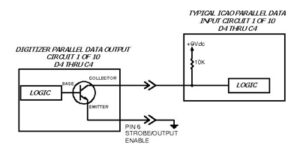
Why do altitude encoding errors occur when connecting a second or third device to the altitude encoder, but not when only one device is connected?
This is a symptom of “Cross-Talk.” This condition typically occurs when the devices connected to the altitude encoder are “pulling-up” to different voltages without diode isolation. When the altitude encoder is in the “off” state the data line electrical current may flow in undesired directions due to this pull-up voltage imbalance. Most modern avionics devices are diode isolated, but in applications where older equipment is mixed with new devices, blocking diodes may be required to isolate the older device. Germanium or Schottky blocking diodes are the preferred devices to install due to the low forward voltage drop across the device. Connect as detailed in the illustration below. Use of general purpose silicon diodes are NOT recommended, as the larger voltage drop may interfere with the logic threshold detection in the equipment.
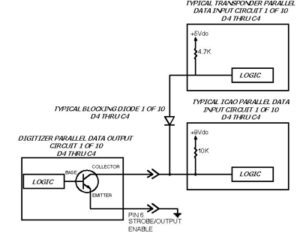
My transponder does not have a D2 or D4 input. What do I do with these signals from the Digitizer?
Leave unused data bits unconnected.
This is a control signal for the ICAO parallel altitude data. On devices manufactured by Trans-Cal this function is on pin 6 of the 15-Pin connector or Pin A of models with 26-pin cylindrical connectors. A “high” or “open” on this pin will disable the ICAO altitude data. A “low” or “ground” on this line will enable the altitude data. Some interconnecting devices may use this signal to control the flow of data from the Digitizer. Be aware that when using this signal and connecting multiple devices to the Digitizer, interruptions of the ICAO data will occur when the controlling device “strobes” the Digitizer.
No, the serial data is independent of the parallel ICAO altitude data. Transmission of the serial data is asynchronous. Enabling or disabling the parallel data will not affect the serial data transmission.
No, the serial data output is completely independent of the ICAO parallel data output.
One device may be driven off each serial port. Trans-Cal Digitizers provide two RS232 ports on each Digitizer, so two RS232 receiving devices may be driven off of each Digitizer.
If more RS232 outputs are required, a serial data repeater such as TCI Model SSD120-100N-SDR is available or Model SSD120-(XX)N-RS5 will provide five RS232 outputs.
Yes. The Digitizer may be configured via the serial port and an IBM compatible PC to specify the data protocol to be transmitted on each serial port. Refer to the calibration and configuration section of the owner/install manual for your specific encoder. The RS485 data will match the TxD1 data.
50 feet in a "talk only" mode. Two way communication, such as calibrating our encoders, is limited to 25 feet.
I have connected the serial data from the digitizer to my GPS device, why does the GPS display a “No Pressure Altitude” message?
There are several possible problem sources. Begin by verifying that the proper output protocol is selected for the device through jumpers or software selection.
|
Device |
Baud Rate/Data Bits/Stop Bits/Parity |
TCI SSD120-(XX)N-RS232 |
|
ARNAV (data in meters) |
9600bps/8/1/None |
None - Software Set-up Only |
|
Bendix/King KT-73 |
1200bps/7/1/Odd |
Software Set-up Only |
|
Garmin |
9600bps/8/1/None |
7 |
|
Trig TT31 |
1200bps/8/1/None |
None |
|
Trimble 2101 |
9600bps/8/1/None |
7 |
|
UPS AT |
1200bps/8/1/None |
None |
|
UPS AT 618 Loran |
1200bps/7/1/Odd |
Software Set-up Only |
NOTE! Connecting pin 2 of the 9-pin D-Sub connector to ground will enable 10-Foot resolution on all TCI encoders.
Other possible problem sources include:
Electrical Ground Imbalance
RS232 operates in an “unbalanced” (single-ended) transmission method; where the receiving device monitors the difference between the signal voltage and a common ground. If a significant difference in electrical ground potential between the Digitizer and the receiving device exists, then the RS232 signal levels may be adversely affected. Verify the digitizer and receiving device electrical grounds are referenced together by connecting one of the ground pins on the Digitizer RS232 connector to the receiving device’s ground.
Receiving Device Configuration
The receiving device is looking for a specific message at a specific baud rate and parity. These messages, baud rates and parity vary from manufacturer to manufacturer. A mismatch on any one of these items will cause a communication failure. In addition, many devices are capable of software configuration to accept RS232 data on different connector pins. Verify the following:
- Digitizer data is routed to the correct connector pin on the receiving device.
- The receiving device is software configured to accept data on that connector pin.
- The receiving device is software configured to accept the correct message protocol at the correct baud rate and parity.
- The Digitizer is transmitting the same message, baud rate and parity as configured in the items above.
Test Equipment
Trans-Cal manufactures a variety of test equipment which will allow the technician to view the serial altitude data.
How can I verify the RS232 data message, baud rate and parity transmitted from the Digitizer?
- Use the Trans-Cal ATS-400 Test Set or the ECP-100 Programmer to display the serial data.
- Use a PC with an open RS232 port and serial data capture software. Some possible software solutions include: HYPER TERMINAL (Windows® 95 & 98 & XP), SOFTWARE WEDGE™, PROCOMM™, VERSATERM™.
- Use a dedicated serial data test box such as the BLACK BOX™ RS232 MONITOR.
- An oscilloscope may be used to view the 9Vdc square wave transmitted about 2/second.
A "syntax error" indicates a command the encoder does not recognize. You may have misspelled a command, or if the encoder was manufactured within the serial number range SRA5001 to SRA7000 independent dual serial output is not supported.
What is the difference between RS232 and RS485?
RS232 operates in an “unbalanced” (single-ended) transmission method; where the receiving device monitors the difference between the signal voltage and a common ground.
RS485 is a balanced (differential) transmission method; where each signal has a dedicated pair of wires, with the voltage on one wire equal to the complement of the voltage on the other. The receiving device monitors the difference between these voltages to determine the signal.
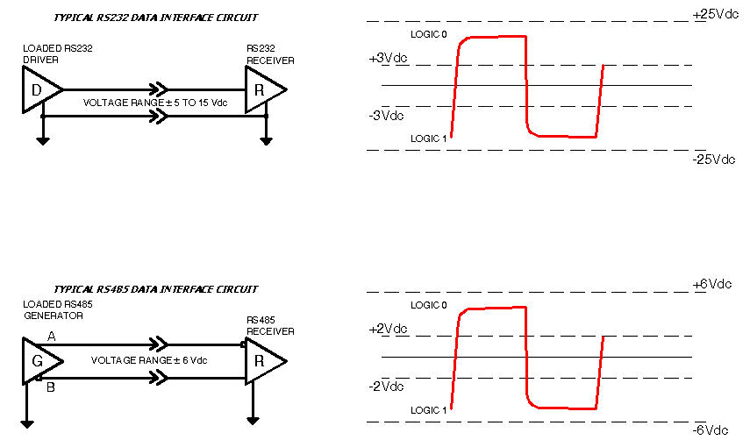
When the “A” terminal is negative with respect to the “B” terminal the logic “1” state exists. When the “A” terminal is positive with respect to the “B” terminal then a logic 0 state exists. Consult Trans-Cal engineering for termination resistor recommendations when connecting more than 2 devices on a RS485 port or if interference with the digitizer data is suspected due to RF noise considerations.
32 Devices.
4000 feet.
Do I need to terminate the RS485 data lines with resistors?
The RS485 data lines may be parallel terminated or un-terminated. Un-terminated data lines are acceptable for the low data rate we are dealing with in most applications. (9600 bps and 2message/sec.) Leaving the data lines un-terminated has the added advantage of keeping the power requirement low. See the illustrations below.
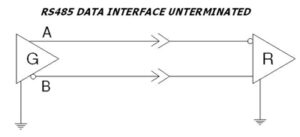
For applications where superior immunity to noise is required with long cable runs and data rates above 115kbps are encountered; then a parallel termination as illustrated below is often recommended. Trans-Cal does NOT recommend using termination resistors! Appropriate signal grounds and shielded cable are usually all that is required to guarantee noise-free operation in the data rate ranges we are working with here. Be aware that termination resistors complicate your installation design and will increase the current consumption!

For a more “in-depth” RS485 discussion, see National Semiconductors’ Application Note AN-1057 “Ten Ways to Bulletproof RS485 Interfaces.” This note is available on the National Semiconductor website.
Do I need to use termination resistors on all the receivers I connect to the RS485 port?
No, in a multi-drop environment, connect termination resistors to the encoder and the receiving unit furthest away from the altitude encoder, as illustrated below. Trans-Cal does NOT recommend using termination resistors! Appropriate signal grounds and shielded cable are usually all that is required to guarantee noise-free operation in the data rate ranges we are working with here.
For applications where superior immunity to noise is required with long cable runs and data rates above 115kbps are encountered; then termination as illustrated below is often recommended. Be aware that termination resistors complicate your installation design and will increase the current consumption!
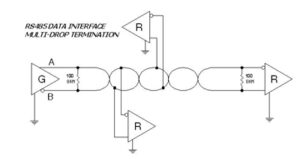
For a more “in-depth” RS485 discussion, see National Semiconductors’ Application Note AN-1057 “Ten Ways to Bulletproof RS485 Interfaces.” This note is available on the National Semiconductor website.
No! Don't do it!
RS422 and RS485 are both balanced (differential) interfaces. The major differences lie in the load that may be driven and the common mode voltage tolerated. RS422 will drive a maximum of ten devices RS485 will drive 32 devices. The “common mode” voltage tolerated by RS422 is ±7Vdc and for RS485 common mode voltage tolerated is +12 to -7Vdc. Common mode voltage is defined as the mean voltage of terminals A and B with respect to signal ground.
No. While some RS422 receivers may tolerate the full common mode voltage of RS485 it is best not to take the chance.
Can I use an encoder labelled "Mod. 1" in my aircraft?
The Mod. 1 unit is designed to allow Trans-Cal encoders to function with early Narco transponders. This modification removes the decoupling capacitors from the Trans-Cal ICAO altitude outputs. These capacitors normally function to prevent RFI (radio frequency interference) from disrupting the analog circuitry within the Trans-Cal digitizers. When installing a "Mod 1" device in an application without the Narco transponder it will still function; however, care must be taken when installing these units in composite structured aircraft. Conventionally manufactured aircraft present little problem due to the large amount of metal present to absorb stray RFI. Great care should be taken to insure that the Mod. 1 encoder is located away from RF emitting devices and fields. The interconnecting wiring harness must be shielded and properly grounded. Additional shielding around the encoder may be required to prevent stray RFI from disrupting the encoder operation. Mounting any altitude encoder too close to radio transmitters with leaky RF connectors can be a source of problems. Contact the factory, if you need additional guidance.
Replacing an SSD120-(XX)A
The model SSD120-(XX)N replaces the older SSD120-(XX)A. Adapter plate part number 103038 is available if you desire to use the existing SSD120-(XX)A mounting tray with the new SSD120-(XX)N.
Replacing an SSD120-(XX)A-RS232
The model SSD120-(XX)N-RS232 replaces the older SSD120-(XX)A-RS232. Adapter plate part number 103038 is available if you desire to use the existing SSD120-(XX)A-RS232 mounting tray with the new SSD120-(XX)N-RS232.